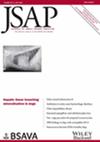A comparison of veterinary classification schemes, serum ascites albumin gradient, and Boyer's criteria in discriminating transudates from exudates in ascitic dogs
Abstract
Objectives
To assess the parameters utilised by and the diagnostic performance of two traditional veterinary classification schemes (named A and B) based on ascites total protein and total nucleated cell count, the Boyer's criteria based on ascites lactic dehydrogenase activity, its serum ratio and the serum total protein, a simplified Boyer's criteria based on ascites lactic dehydrogenase activity and serum total protein only, and finally the serum-ascites albumin gradient in discriminate the pathophysiological origin of the ascites formation in dogs.
Materials and Methods
Cross-sectional study including 291 client-owned dogs with ascites. Ascites aetiology was used to classify the pathophysiology of its formation. Parameters measured and calculated included ascites total protein, ascites total nucleated cell count, ascites lactic dehydrogenase activity and its serum ratio, serum total protein, and the serum-ascites albumin gradient.
Results
There were 33 transudates due to decreased colloid osmotic pressure, 69 transudates due to increased hydrostatic pressure gradient, and 189 exudates. Simplified Boyer's criteria misclassified 16 of 291 ascites (94.5% accuracy; 95% confidence interval: 91.2 to 96.8) and Boyer's criteria misclassified 21 of 291 ascites (92.8% accuracy; 95% confidence interval: 89.2 to 95.5). The traditional veterinary classification scheme B misclassified 71 of 291 ascites (75.6% accuracy; 95% confidence interval: 70.3 to 80.4) and scheme A 130 of 291 (55.3% accuracy; 95% confidence interval: 49.4 to 61.1). Finally, the serum-ascites albumin gradient misclassified 100 of 291 ascites (65.6% accuracy; 95% confidence interval: 59.9 to 71.1).
Clinical Significance
The Boyers' criteria and a simplified Boyer's criteria were highly accurate in discriminating exudates from transudates, while the other classification schemes had significantly less diagnostic value in doing so.

 求助内容:
求助内容: 应助结果提醒方式:
应助结果提醒方式:


